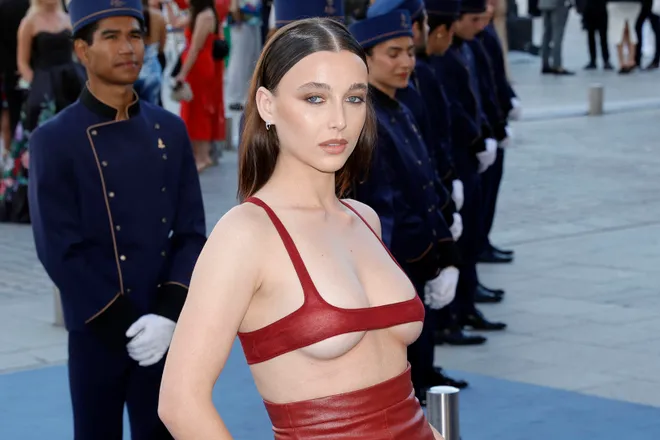Social media influencers tell you to buy, buy, buy. Stop listening to them.
Americans' credit card debt soared to a startling $1.13 trillion at the end of last year. The majority of that debt can be attributed to rising interest rates and the higher cost-of-living overall, but an estimated 7% of Americans are compulsive shoppers, accumulating significant credit card debt through hundreds of nonessential purchases.
The enticements to buy are never-ending. Spend five minutes scrolling through influencer content on social media and you’ll encounter an array of expensive products flung in your face in the form of subscriptions, skincare aids, exercise equipment and just about anything else you can imagine.
From everyday advertisements to shopping haul videos to the popular “what I spend in a day” motif, influencers are pushing purchase after purchase at their viewers. It’s no surprise that purchases of personal care items and clothing are on the rise, with the majority of that spending considered nonessential. Americans are overspending, falling victim to overconsumption and perpetuating a cycle of wastefulness.
Social media shamelessly promotes materialism. Advertising is everywhere on social platforms − not just when influencers shower praise on the brands that sponsor them, but also in each strategically placed item facing the camera, brand name out.
Lifestyle influencers’ platforms often focus on strategies for happiness and well-being, showcasing an idyllic life that involves little beyond a daily workout in expensive clothing and aesthetically pleasing meals. The message is that money can buy you love − and happiness. You just need to spend it all to have it all.
College degrees still matter:Young conservatives like me are told not to attend college. That's shortsighted.
Influencers create a false sense of reality
Sure, we know that these lifestyles aren’t realistic, but it’s all too easy to believe that influencers' routines are candid, accurate representations of the creators' daily lives.
What many consumers – myself included – often fail to recognize is that social media is a business. A survey conducted by Later found that 94% of influencers make money via brand partnerships – when a brand pays the influencer to market their product to their viewers.
Many influencers make a large part of their profits through Amazon Storefronts, where they link products that they display and encourage viewers to shop from there. It’s anyone’s guess whether the content creators actually like or even use the products.
Influencers capitalize off of their viewers’ compulsive buying habits, equating their seemingly perfect lives with the amount of goods they own. Lifestyle influencers love to display their thousands of beauty products, dozens of Amazon packages on their doorsteps and color-coded fully stocked fridges as the secrets for a romantic life. Their content is based on the idea that their happiness, or at least the illusion of happiness, is found through stuff. Want to be as organized and put-together as me? Shop these products through the link in my bio!

Never mind that most of the lifestyles portrayed online are unattainable (and often staged). We still grow jealous of the wealth and fame that influencers flaunt.
Content creators keep pushing us to buy more, more, more, and a recent study found that social media use has a correlation with materialism, promoting the desire for more and more possessions. Yet, contrary to popular belief, owning more “stuff” has been demonstrated to be detrimental to overall life satisfaction.
No Instagram, no TikTok:I wasn't allowed a smartphone until I was 16. I can't thank my parents enough.
This overconsumption of products marketed on social media is not only dangerous for your wallet; it’s also bad for the environment.
The lifestyle that internet personalities advertise is incredibly wasteful. Any fridge or pantry restock video features dozens of single-use plastic items arranged pleasingly in organized acrylic bins ‒ individually wrapped snacks, plastic bottles of water, soft drinks in aluminum cans. This amount of waste is unjustifiable, especially because it’s more about aesthetics than practicality.
Influencers push fast fashion that hurts the environment
Even worse, social media has contributed to the rise of fast fashion: cheap, mass-produced clothing that caters to trendiness rather than quality. This results in mind-blowing amounts of textile waste and water pollution from dyes, as world consumption of clothing has increased by 400% in the past 20 years.
Then there are the accusations of labor law violations and personal information theft from major fast-fashion retailers such as Shein and Temu.
The primary goal of influencers is to make money, not help their viewers make smart purchases.
Most of us don’t get paid to have a 17-step skincare routine. Influencers do. Their job is glorified advertising. And guess what? You don’t need most, if not all, of the products that they claim you do.
We need to think about where and why we spend our money. If it’s to mimic a 45-second video of people who film themselves getting out of bed in the morning, maybe put away your wallet.
You’ll probably be happier and the earth will, too.
Christine Schueckler is a USA TODAY Opinion intern and a rising third year student at the University of Virginia, where she studies English and French. At UVA, she writes for The Jefferson Independent and performs with the UVA University Singers.
Disclaimer: The copyright of this article belongs to the original author. Reposting this article is solely for the purpose of information dissemination and does not constitute any investment advice. If there is any infringement, please contact us immediately. We will make corrections or deletions as necessary. Thank you.







